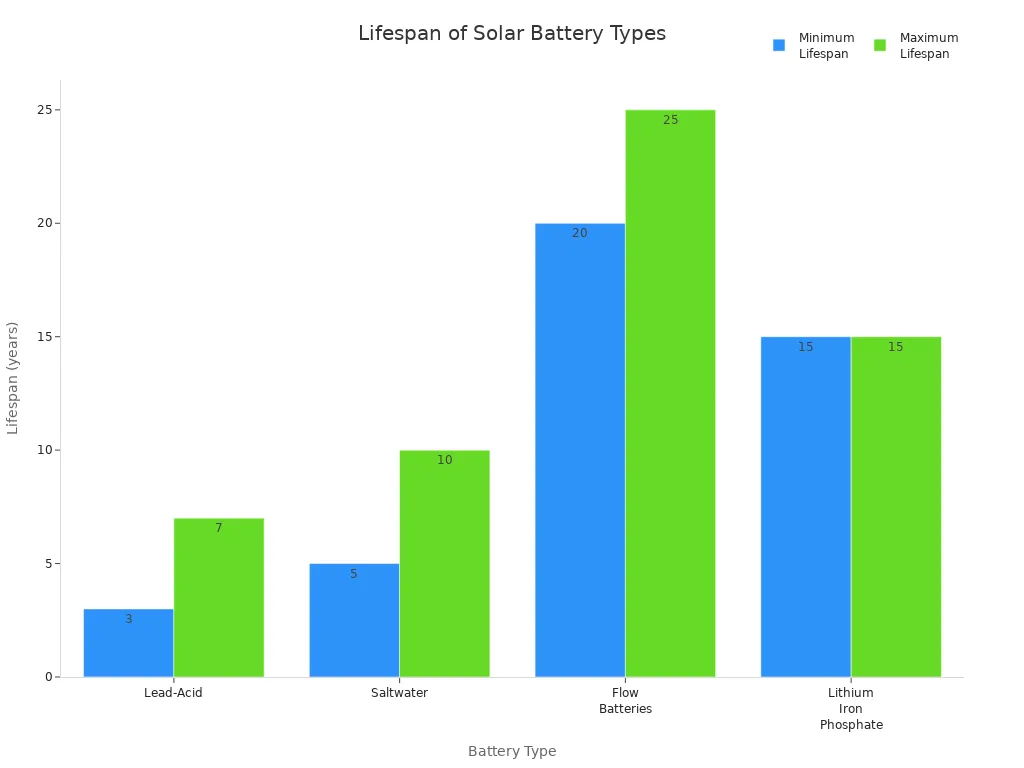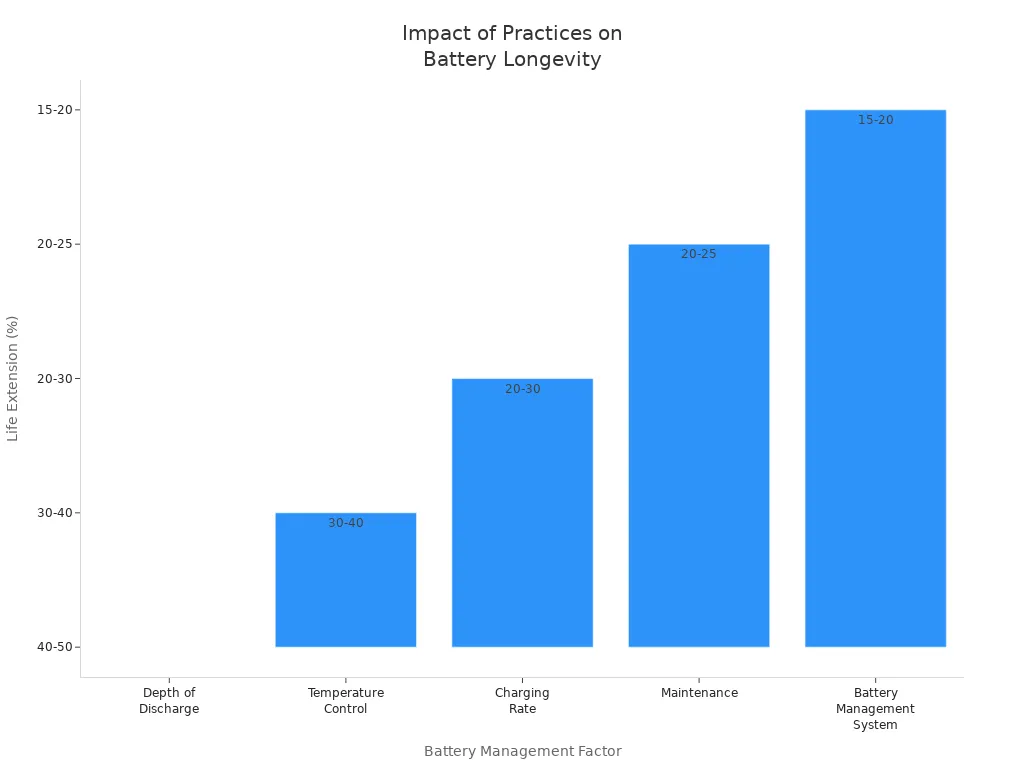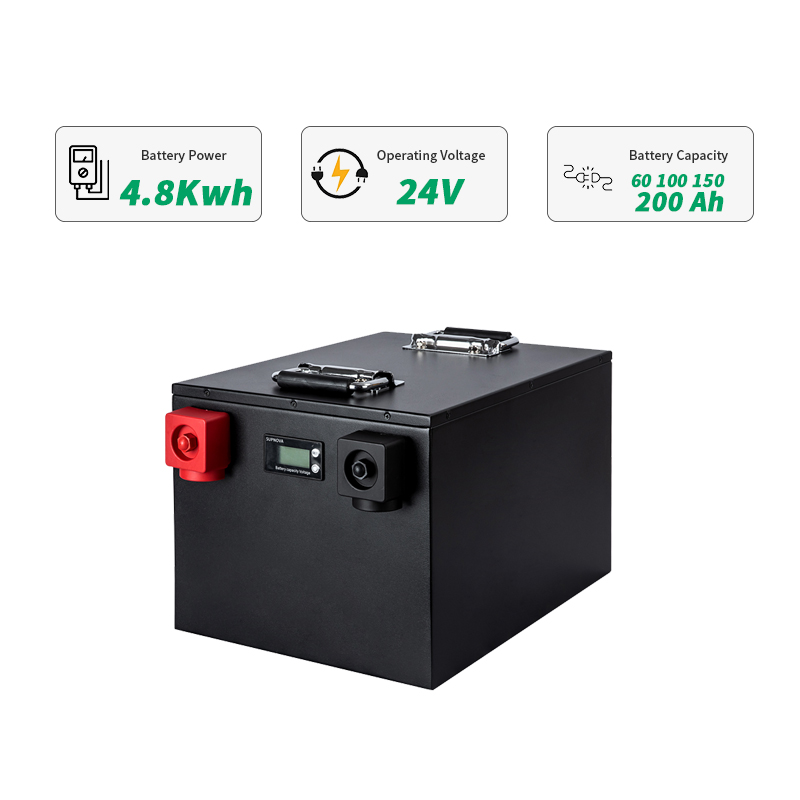+86 17727759177
inbox@terli.net
- All
- Product Name
- Product Keyword
- Product Model
- Product Summary
- Product Description
- Multi Field Search
Views: 0 Author: Site Editor Publish Time: 2025-07-26 Origin: Site
Most solar panel batteries last 5 to 15 years. How you use and care for them matters a lot. You will need to replace the solar battery at least once. This is because solar panels last 25 to 30 years. The solar battery lifespan depends on many things. These include battery type, temperature, usage, and maintenance. Look at this chart to see how battery type changes lifespan:
If you know what affects battery lifespan, you can make better choices. This helps you get the most from your money.
Most solar panel batteries last 5 to 15 years. You will probably need to replace them once. This is because solar panels last 25 to 30 years.
Battery type, how you use it, temperature, and care matter a lot. These things change how long your solar battery lasts. Lithium iron phosphate batteries last the longest. They also need the least care.
Keep your battery in a cool, dry place. Do not use all its power at once. This helps it last longer and work better.
Check your battery’s health often with apps or monitors. This helps you find problems early. It can make your battery last up to 50% longer.
Look for signs like less energy storage, slow charging, or swelling. These signs mean you should replace your solar battery soon and safely.
You want your solar battery to last a long time. How long it lasts depends on the battery type. Some batteries work longer than others. Here is a table that shows how long each battery type usually lasts and what makes them different:
| Battery Type | Typical Lifespan | Key Characteristics |
|---|---|---|
| Lead-Acid | 3-7 years | Low upfront cost, needs lots of care |
| Saltwater | 5-10 years | Good for the planet, safe, but stores less energy |
| Flow Batteries | 20+ years | Can be made bigger, does not wear out fast, used in businesses |
| Lithium Iron Phosphate (LFP) | Up to 15 years | Works well in heat, can be used often, long warranties |
You can also look at this chart to see how long each battery type lasts:

Most people use lithium-ion, lead-acid, or saltwater batteries at home. Here is a short list:
Lithium-ion batteries last about 10 to 15 years. They hold a lot of energy and last longer than most.
Lead-acid batteries work for 5 to 10 years. Flooded types need more care, but sealed ones cost more and need less work.
Saltwater batteries last close to 10 years. They are better for nature and do not break down as fast.
Most solar batteries last between 5 and 15 years. You will probably need to get a new battery at least once while using your solar panels. Flow batteries can last over 20 years, but people do not use them much at home.
You will have to replace your battery because it does not last as long as solar panels. Solar panels can work for 25 years or more, but batteries do not last that long. Here are some main reasons:
Solar batteries get old because of chemical changes inside.
Every time you use the battery, it loses a little power.
After about 10 years, most batteries cannot hold as much energy.
Most solar battery warranties last about 10 years, which matches how long they work.
You can get a new battery without changing your whole solar panel system.
⚡ Note: Solar batteries have parts inside that move and wear out, but solar panels do not. This is why batteries do not last as long and why you need to plan to replace them.
If you keep track of your battery’s age, you can stop power problems and keep your system working well. Knowing how long batteries last helps you save money for a new one and get the best value from your solar setup.
Many things change how long your solar battery works. If you know these things, you can help your battery last longer. Let’s see what matters most for solar battery life.
The battery you pick changes how long it will last. Different batteries need different care and have different safety features. Here’s a table to compare them:
| Battery Chemistry | Cycle Life (full cycles) | Depth of Discharge (DoD) | Maintenance Needs | Thermal Stability & Safety | Longevity (Years) |
|---|---|---|---|---|---|
| Lithium Iron Phosphate (LFP) | 6,000 - 10,000 | Up to 80% | Minimal (no electrolyte checks) | High stability, safer, less overheating risk | 15 - 20 |
| Other Lithium-ion (NCA, NMC) | Fewer than LFP | Up to 80% | Minimal | Less stable than LFP | Less than LFP |
| Lead-Acid | Fewer cycles (less than 2,000) | Recommended ~50% | Regular electrolyte checks and terminal cleaning | Lower thermal stability, more degradation | 3 - 5 (typical) |

Lithium iron phosphate batteries last the longest and need little care. Lead-acid batteries do not last as long and need more work. The battery chemistry you choose sets how well your solar battery works.
How you use your battery changes how long it lasts. Off-grid systems use batteries every day, so they wear out faster. Grid-tied systems use batteries only when the power goes out, so they last longer.
Off-grid batteries work hard every day.
Grid-tied batteries are used less and last longer.
Most batteries get old just from time, not from use. Even if you do not use your battery much, it still gets older. Keeping your battery charged and cool helps it last longer.
Depth of discharge (DoD) is how much energy you use before charging. If you use more energy each time, your battery will not last as long. Using only half the battery each time gives you more cycles. Using most of the battery makes it wear out faster.
Tip: Try to keep your battery between 20% and 85% charged. This helps your battery last longer.
Lithium-ion batteries can handle deeper discharges better than lead-acid. Using the right DoD for your battery is very important.
Where you keep your battery matters a lot. Hot places make batteries age faster and can be unsafe. Cold places slow batteries down and lower their power. Wet places can cause rust or shorts.
Keep your battery in a cool, dry spot.
Use fans or covers to control temperature.
Do not put batteries in the sun or in wet places.
A study found that batteries at 113°F lost power twice as fast as those at 77°F. Controlling temperature is very important for battery life.
Taking care of your battery helps it last longer. Here are some easy steps:
Clean your battery and its ends to stop rust.
Check charge levels often and do not overcharge or drain too much.
Store batteries the right way when not using them.
Update software and check battery health with apps.
Have a pro check your system sometimes.
If you take care of your battery, you can find problems early. This helps your battery last longer and keeps your money safe.

48V 100Ah Lithium Ion Battery Energy Storage System
Picking the right solar battery is important. It can change how well your solar system works. Each battery type has good and bad points. Let’s check out the most common choices for solar battery storage.
Most people use lithium-ion solar batteries at home now. They can last up to 15 years. You can charge them over 10,000 times. These batteries hold lots of energy in a small size. They do not need much care. They also charge faster than other batteries. Look at this table to see how they compare:
| Battery Type | Lifespan (Years) | Cycle Count | Additional Notes |
|---|---|---|---|
| Lithium-ion | Up to 15 years | Over 10,000 cycles | Longest lifespan, high energy density, low maintenance |
⚡ Tip: A battery management system, or BMS, helps stop overcharging. It keeps your lithium-ion solar batteries working well.
Some problems can happen with these batteries. They can lose power after many charges. They can get voltage problems or get hurt by heat. You can stop most problems by keeping them cool. Always follow the care tips from the maker.
Lead-acid batteries are older but still used a lot. They cost less at first but only last 3 to 7 years. You must check water and clean the ends often. These batteries are heavy and need more space. Here is a table to compare:
| Battery Type | Lifespan (Years) | Cycle Count | Additional Notes |
|---|---|---|---|
| Lead-acid | Up to 7 years | 2,000 to 3,000 cycles | More affordable, bulky, requires regular maintenance |
Flooded lead-acid batteries need the most care. They last 3 to 5 years.
Sealed types, like AGM or Gel, last a bit longer. They do not need as much work.
If you use your solar battery every day, lead-acid batteries wear out faster. They also wear out faster if you use up all their power often.
Saltwater batteries are new for solar storage. They use water-based electrolytes, so they are safe and not toxic. You can use all their power without hurting them. They last about as long as lithium-ion batteries. But they hold less energy and cost more right now.
| Battery Type | Lifespan (Years) | Cycle Count | Additional Notes |
|---|---|---|---|
| Saltwater | Similar to lithium-ion | N/A | Newer technology, non-toxic, recyclable, lower energy density, higher cost |
Saltwater batteries can be used about 5,000 times.
They do not get too hot and are easy to recycle.
They are good for homes that want safe and green energy storage.
Other batteries, like flow batteries, last even longer. They need little care but are big and cost a lot. Most homes do not use them.
Here is a quick look at the main good and bad points for each solar battery type:
| Battery Type | Lifespan (Years) | Maintenance Requirements | Advantages Related to Lifespan and Maintenance | Disadvantages Related to Lifespan and Maintenance |
|---|---|---|---|---|
| Lead-Acid | 3-7 | Regular maintenance needed | Affordable, proven technology | Shorter lifespan, bulky, needs care |
| Lithium-Ion | 5-15+ | Low maintenance | Long lifespan, high energy density, less care needed | Sensitive to heat, higher cost |
| Saltwater | 5-15 | Low maintenance | Safe, non-toxic, recyclable, deep discharge possible | Lower energy density, higher price |
| Flow Batteries | 20+ | Minimal maintenance | Very long life, safe, scalable | Bulky, costly, not common for homes |

Note: Battery technology keeps getting better. Lithium iron phosphate batteries now last longer and are safer than before.
Think about how often you will use your solar battery. Think about how much care you want to give it. Also, think about your budget. This will help you choose the best battery for your solar system.
You can help your solar battery last longer by making smart choices when you install it. First, figure out how much energy you use and how much money you can spend. This helps you choose the right size for your system. Always hire a certified installer. Experts know how to set up solar panels, batteries, and inverters the right way. Put your solar battery in a cool, shady place. Heat makes batteries wear out faster, so keep them out of the sun. If you live somewhere hot, use fans or vents to keep things cooler. Make sure your system fits your home’s power needs, especially if you use big appliances. If you already have solar panels, ask a pro if your system can handle new batteries. Always follow local rules and get the right permits before you start.
️ Tip: Start with remote monitoring systems. These help you watch your battery’s health and keep your warranty safe.
Taking care of your solar battery helps it last longer. Clean the battery ends with a gentle mix of distilled water and baking soda. This stops rust and keeps the battery working well. If you have lead-acid batteries, check the water level often. Put special grease on the ends to stop rust. Clean your solar panels at least twice a year. This helps them make more energy for your battery. Always follow the maker’s rules for taking care of your battery. Be careful and watch for gas or fire risks, especially with lead-acid batteries.
Watching your battery helps you find problems early. Use energy management systems and apps to check charge, temperature, and use. These tools help you keep your battery charged between 20% and 80%. This range helps your battery last longer. Apps send alerts if something is wrong, so you can fix it fast. Sensors check voltage and temperature to keep your battery safe. By checking your battery often, you can stop deep discharges and overcharging. This can make your battery last up to 50% longer. Using these tools gives you more control and helps you get the most from your solar battery.

OEM cheap Lifepo4 24v battery 150ah auto batteries
You want your solar battery to work well every day. But as time goes on, it can start to wear out. There are some signs that show your solar battery needs to be replaced:
The battery does not store as much energy as before, even after a sunny day.
You see more low voltage warnings from your inverter or charge controller.
Charging takes longer, even when your solar panels are working well.
Your lights or devices flicker, turn off, or restart without warning.
The battery feels hot, or you see swelling or bulging on the outside.
You notice leaks or rust, especially with lead-acid batteries.
The battery loses its charge quickly or cannot keep a charge at all.
You hear odd noises, smell something strange, or see damage.
If you notice any of these problems, your solar battery might not be safe or work well. Batteries with these issues can cause power loss or even safety problems. You should plan to get a new solar battery soon to keep your system working right.
⚠️ Tip: Batteries older than five years are more likely to have these problems. Check your battery often so you can find issues early.
Most solar battery warranties last 10 to 12 years. These warranties say your battery should keep about 70% of its starting power during this time. If your battery drops below this, you can usually get a new one. Some companies give longer coverage, up to 30 years, but only if the battery keeps at least 50% of its first power.
Warranties have rules you must follow. You need to use the battery the way the maker says and keep it connected to a monitoring service. If you use your battery too much or the wrong way, the warranty might not help. Most warranties pay for the battery and shipping, but not for labor or damage from bad setup or weather.
When your battery is used up, you should recycle it at a special center. Recycling keeps harmful metals out of the ground and water. It also helps save important materials like lithium and lead. Recycling helps the planet and cuts down on waste.
♻️ Note: Never throw old solar batteries in the trash. Recycling helps the environment and follows local rules.
Most batteries last between 5 and 15 years. How you take care of them is very important. Keep your battery in a cool place to help it last longer. Try not to use up all the battery’s power at once. Check your battery often to catch problems early. Pick the best battery type for your needs. Put the battery somewhere safe in your home. Doing regular checks helps you find issues before they get worse. This protects your money. Plan to replace your battery when needed. Use rebates to help save money when you buy a new one.
Your battery might not keep a charge anymore. You could see your lights flicker or get warning messages. If your battery is older than five years and has these problems, you should think about getting a new one.
Yes! Keep your battery in a cool place. Try not to use up all its power at once. Follow the maker’s care tips. Use an app to watch your battery’s health. Checking your battery often helps you find problems early.
An old battery might lose power fast or stop working. Your solar system could turn off or become unsafe. Getting a new battery keeps your power safe and steady.
Yes, you can take solar batteries to special recycling centers. Recycling stops bad materials from going into landfills. It also helps keep the planet safe. Always follow your local rules when you throw away batteries.